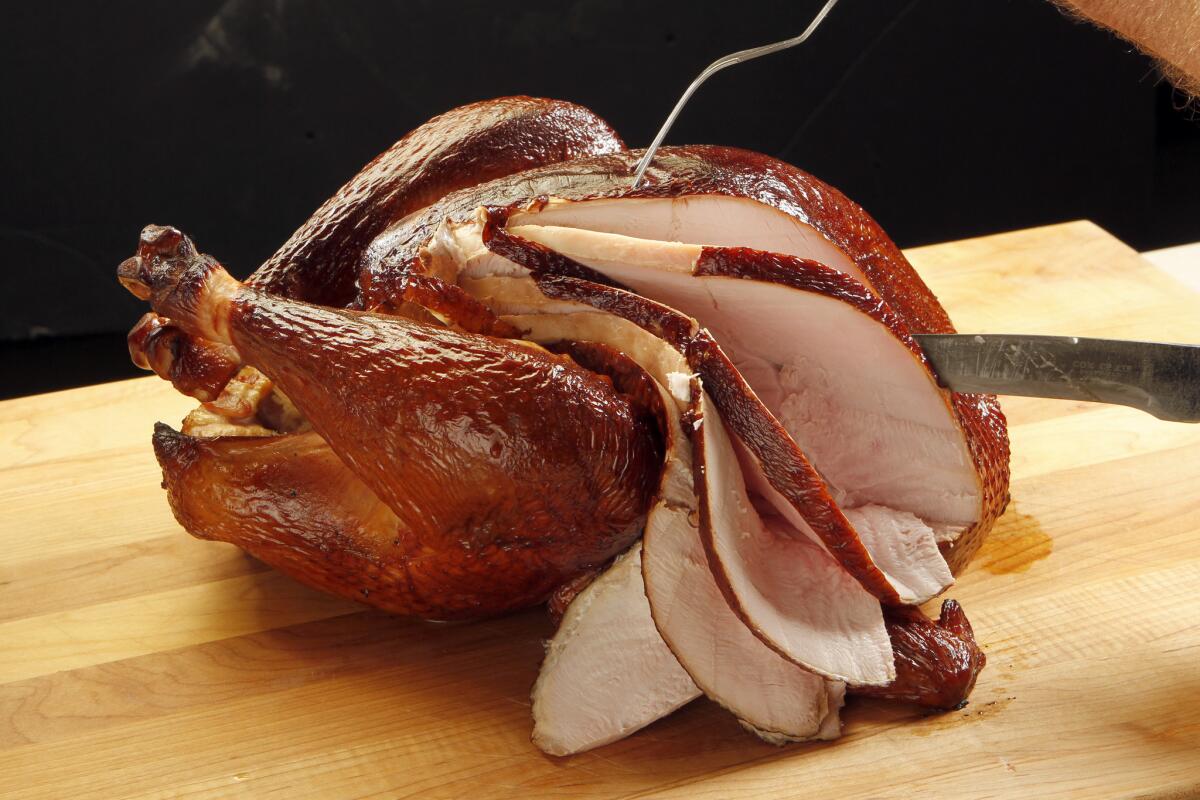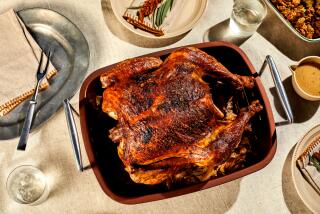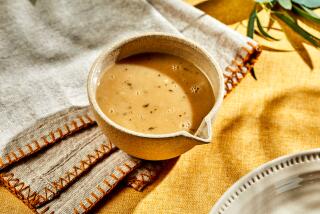Recipe: Barbecued turkey

Recipe: Barbecued turkey.
For something that is the centerpiece of almost every Thanksgiving dinner, the turkey gets surprisingly little attention. At least from most normal people. They tend to stuff it, roast it and forget it. And then they complain about how boring turkey is for another year.
Not at my house. I love the big bird, and I’m always trying to find new ways to make it even better. And I’ve got to say that my newest improvement may be the best yet.
For years, my Thanksgiving ritual revolved around soaking the big bird in a big bucket of brine that kept it juicy and well-seasoned even after a long roast. Then I discovered I could get the same improvement in moistness and flavor by dry-brining -- simply rubbing the turkey with kosher salt (1 tablespoon for every 5 pounds of weight). No more juggling that big bucket and, in fact, the texture is even better, meatier.
Last year, I played with flavoring the salt with different spices, herbs and citrus zests, and that worked well too. I thought my turkey-tweaking days were done. But then a reader e-mailed and asked whether this spiced brining could work for turkey on the grill. And a new fire was lighted.
The challenge to cooking turkey on the grill is obvious: size. But so are the potential advantages: Imagine bringing your own lightly smoked turkey to the table, and also think about having your oven freed up for the crucial work of other last-minute cooking.
At first I was intimidated. The biggest thing I’ve ever grilled before was a 6-pound leg of lamb. Even the smallest turkey is about twice that size. My first thought was to spatchcock it, as I sometimes do with grilled chicken: Remove the backbone and flatten the bird so that it will lie flat on the grill and cook evenly. But then I realized how I’d feel bringing a turkey to the Thanksgiving table that looked like it had been run over by a car.
So I decided to take a gamble and just try to plop the whole mountain of meat on the grill intact. Surprisingly, it worked perfectly, and it couldn’t be easier.
Trolling barbecue websites and cookbooks, I found all kinds of suggestions for how best to do this. Put the turkey on a roasting rack; put it in a roasting pan; start it on the breast and turn it to the back; start it on the breast and turn it to the sides and back, ad infinitum.
I’m a simpler-is-better kind of cook, though, so for my first try I decided to cut through the clutter and simply put the turkey on the grill on its back and leave it at that. It worked perfectly. Two hours later, I had a gorgeous, mahogany-brown smoked turkey. No muss, no fuss, no bother. Why complicate things?
The particulars
There was some fine-tuning along the way.
* First, two hours is a long time for anything to be on the grill. In order to keep the turkey from burning, you have to be sure to wait to put it on until after the coals have died down enough to be covered with a fairly uniform layer of gray ash; you want the temperature to be between 300 and 325 degrees.
* Tuck the extremities (drumsticks and wingtips) securely to the bird to keep them from scorching.
* Cook over indirect heat. That’s not easy to do with something as big as a turkey; what works best is to bank the coals against either side of the grill. Find an old loaf pan and put it in the center to keep the center free. Even better, fill the bottom of the pan with ash from your last fire to help prevent any flare-ups.
* You’ll probably need to add more briquettes along the way, so have them ready (they don’t need to be lighted). A half-dozen on each side every 45 minutes should do the trick. My grill comes with “wings” on both sides that lift up to allow the addition of briquettes. If yours doesn’t, you’ll need to lift the entire grill up to add them; make sure you have a table nearby to rest the turkey on -- and that it’s covered with newspaper.
* Choosing the right-size turkey is, of course, imperative. You want to be sure there’s at least an inch clearance between the tip of the breast and the grill cover, which means you shouldn’t try a turkey bigger than 15 to 16 pounds.
* If you want more than a faint smoky flavor, you’ll need to add wood chips. I prefer hickory, but experiment and use what you like best. Be judicious, though. With the long smoking, the flavor can get overpowering and bitter. I found that about 1/4 pound of wood chips, soaked, gives the right amount of smoke for most turkeys.
Turkey dry-brined and grilled this way tastes great just as it is. The skin is dark and crisp; the meat is moist and flavorful and lightly perfumed with smoke. But of course, there’s nothing that can’t be made better.
I experimented with a couple of spice rubs that I thought would complement the hint of smokiness. The first is a mixture of warm pepper spices -- black pepper, allspice, cloves and a hint of cumin -- with orange zest added for a little citrus lift. I also tried one that goes in more of a roast-chicken direction with combined dried mustard, thyme and lemon.
Both work well, but the flavorings are subtle. And as delicious as a simply smoked turkey is all by itself, you might just want to leave well enough alone. At least until next year.
Barbecued turkey
Total time: 3 1/2 hours, plus 3 days brining time
Servings: 14 to 16
Our recipes, your kitchen: If you try any of the L.A. Times Test Kitchen recipes from this week’s Food section, we want photographic evidence: Click here to upload pictures of the finished dish.
1 (15- to 16-pound) turkey
3 tablespoons kosher salt, orange-pepper salt or lemon-thyme salt
1/4 pound hickory chips
Oil, for brushing the turkey
1. Wash the turkey inside and out, pat it dry and weigh it. Measure 1 tablespoon of kosher salt or the appropriate amount of a seasoned salt into a bowl for every 5 pounds the turkey weighs (for a 15-pound turkey, you’ll need 3 tablespoons of kosher salt).
2. Sprinkle the inside of the turkey lightly with salt. Salt the outside, concentrating the salt where the meat is the thickest — on the breasts and thighs. It should look liberally seasoned but not oversalted.
3. Place the turkey in a 2½ -gallon sealable plastic bag, press out the air and seal tightly. If you can’t find a large plastic bag, use a small garbage bag. Place the turkey in the refrigerator. Chill for 3 days, leaving it in the bag but turning it and massaging the salt into the skin every day.
4. Remove the turkey from the bag. There should be no salt visible on the surface, and the skin should be moist but not wet. Wipe the turkey dry with a paper towel, place it breast-side up on a plate and refrigerate uncovered for at least 8 hours.
5. On the day it is to be cooked, remove the turkey from the refrigerator and leave it at room temperature at least 1 hour. Be sure the drumsticks and wingtips are secured to the body to prevent scorching.
6. Place the wood chips in a pan and cover with water. Start the fire: Light the charcoal in a chimney and place a bread loaf pan in the center of the coal area of the grill’s firebox (fill the loaf pan with ash to prevent flare-ups). When the coals are well lighted, distribute them evenly on either side of the loaf pan and let them burn until they are coated with ash.
7. Drain the wood chips and put them on top of the charcoal. Place the grill on top of the firebox.
8. Lightly brush the turkey with oil, then place it on top of the grill, centered in line with the loaf pan. Cover.
9. After 30 minutes, check the fire. If the coals are starting to die down, add another half-dozen on both sides to maintain an even, slow heat. If you use an oven thermometer, it should read in the 300- to 325-degree range.
10. Cook, adding more coals as necessary, until a thermometer inserted in the deepest part of the thigh, but not touching the bone, reads 165 degrees, about 2 to 2½ hours total grilling.
11. Remove the turkey from the grill, transfer it to a warm platter or carving board and tent loosely with foil. Let stand at least 30 minutes to let the juices redistribute through the meat. Carve and serve.
Orange-pepper salt: In a spice or coffee grinder, grind 2 teaspoons orange zest (about 2 oranges), one-half teaspoon whole cumin, 2 teaspoons whole black pepper, 4 whole cloves and 6 whole allspice to a fine powder. Add one-quarter cup kosher salt and grind again to distribute evenly.
Lemon-thyme salt: In a spice or coffee grinder, grind 2 tablespoons fresh thyme leaves, 1 teaspoon lemon zest (about 1 lemon), 1 teaspoon dry mustard and one-half teaspoon garlic powder to a fine powder. Add one-quarter cup kosher salt and grind again to distribute evenly.
Each of 16 servings: 496 calories; 68 grams protein; 0 carbohydrates; 0 fiber; 23 grams fat; 7 grams saturated fat; 230 mg cholesterol; 0 sugar; 477 mg sodium.
More to Read
Eat your way across L.A.
Get our weekly Tasting Notes newsletter for reviews, news and more.
You may occasionally receive promotional content from the Los Angeles Times.











